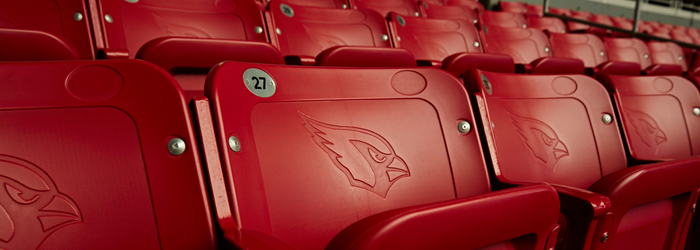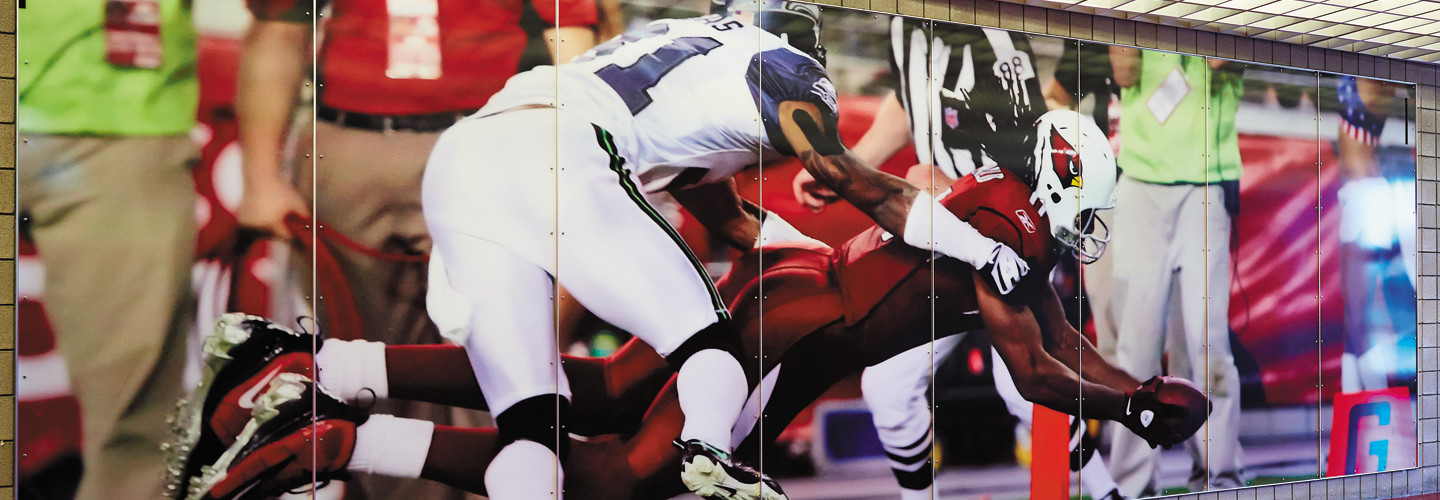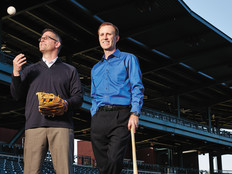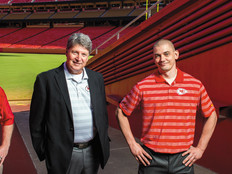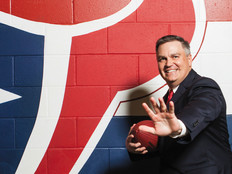Arizona Cardinals Deploy Flexible, Secure Stadium Wi-Fi Ahead of Super Bowl XLIX
Since the Arizona Cardinals first took the field at University of Phoenix Stadium in 2006, the venue has earned praise from all corners. Business Week called the facility one of the top 10 stadiums in the world that year. Sports Illustrated in 2010 named it the best new venue of the 2000s.
Rather than rest on its laurels, however, the Cardinals organization has been hard at work.
“We put in the best technology available at the time for an NFL venue,” says Mark Feller, vice president of technology for the team. But, “technology is constantly enhanced, so we’ve been improving the stadium infrastructure ever since we opened it.”
The Cardinals upped the ante this year with a massive upgrade to Cisco Connected Stadium, which includes new Wi-Fi, security and unified communications systems, along with additional fiber and hundreds of new access points throughout the 63,400-seat stadium.
Wi-Fi in major sports stadiums is still not the norm, but a growing number of teams are following the Cardinals’ playbook. Those leading the way in IT upgrades — the Atlanta Falcons, Washington Redskins and Kansas City Chiefs — are realizing great success.
“I think we’ll see this spread across the remaining teams,” predicts Ken Rehbehn, principal analyst at 451 Research (formerly Yankee Group). “It’s nearly a force of nature now.”
But, for Feller and his colleagues, “it wasn’t only about keeping pace. We’re in the entertainment business, and part of entertaining folks is giving them the capability to use social media to track information and communicate with their friends and families while they’re at our events. We want to make sure that our fans are coming to our stadium instead of staying home and watching the game on TV.”
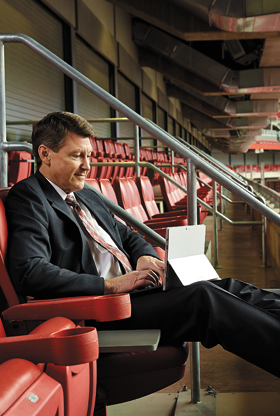
Photo: Steve Craft
“We’re in the entertainment business, and part of entertaining folks is giving them the capability to use social media to track information and communicate with their friends and families while they’re at our events.”
Mark Feller, Vice President of Technology for the Arizona Cardinals.
Thinking Beyond Football
The Cardinals have never had a problem convincing fans to make it to the stadium: “We’ve sold out every game that we’ve played here — and that is 91 and counting,” Feller says.
But upgrades weren’t just aimed at pleasing Cardinals fans. The venue also hosts this year’s Fiesta Bowl, NFL Pro Bowl and the upcoming Super Bowl XLIX, and it will host the College Football Championship after next season. It has housed sold-out concerts by the likes of One Direction, Kenny Chesney and U2, as well as smaller trade expositions, car and RV sales shows and business conferences.
“The technology that we deployed had to be flexible to be able to handle the great demand and the smaller events as well,” Feller says.
It was worth the investment, he adds, because it attracts a wide variety of events and enables the organization to better market to visitors, which amortizes the costs of the upgrades, resulting in a quicker return on investment.
“It’s good business,” Rehbehn says of deploying strong Wi-Fi networks in stadiums. “It creates opportunities for teams to strengthen the relationships they have with the fans.”
The upgrades at University of Phoenix Stadium were also driven by external factors. For starters, security breaches are no longer the exceptions to the rule.
“Home Depot, Target — all of these huge corporations were breached and may have been compromised,” Feller explains. “We wanted to make sure we did as much as possible to prevent anything like that.”
Confirming AP Locations and SSIDs
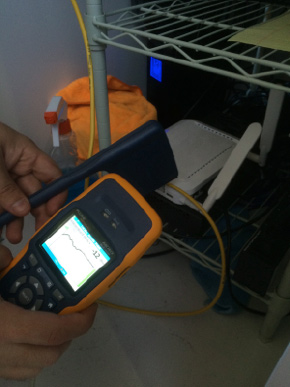
With nearly 850 access points (APs) deployed in the University of Phoenix Stadium, it was important to ensure that each AP was installed in the correct location and servicing the correct SSIDs. CDW used the Fluke AirCheck Wi-Fi Test Tool to confirm this information.
The handheld AirCheck is a purpose-built Wi-Fi testing device that’s fast, accurate and convenient. Its quick scan rate and feature-rich software make short work of validating an access point’s host name and the SSIDs that it’s servicing.
—Craig Coolidge, CDW Networking Practice Lead
Learn more about CDW's access point work in the Cardinals' stadium on the CDW Blog.
Another driver has been the explosive growth of mobile devices. When the stadium opened in 2006, there were some smart devices with Wi-Fi capability, “but the personal technology that we all carry around and almost take for granted now really wasn’t available nine years ago,” says Feller. “We didn’t have to support thousands of people using Wi-Fi-connected devices when we built the stadium.”
Plus, he adds, Wi-Fi standards in 2006 “paled in comparison” to those of today. The Cardinals also sought a scalable infrastructure capable of accommodating technology advancements. The organization has already added a video feature, allowing fans to watch live-camera video, replays and a variety of camera angles on their mobile devices. “We’ve got a lot of creative people in the company, and when they come up with ideas, we can always say, ‘We can do that,’ instead of saying, ‘No, we don’t have the capabilities,’ ” Feller says. “That’s a lot of fun, being able to say ‘yes.’ ”
Building the Cardinals' Wi-Fi Playbook
Saturday, Aug. 9, 2014, was the deadline for having the bulk of the new system in place. The day marked the Cardinals’ first preseason game against the Houston Texans. Their fans would fill the stands regardless of whether the upgrade was complete.
“That was our target date, and it wasn’t going to move,” Feller says. Fortunately, his team spent so much time interviewing technology partners and discussing options that by the time they tapped CDW in April, much of the plan was already in place.
“We were able to hit the ground running,” Feller says. “And it was kind of a sprint, because we had about three months to get everything going.”
With a project of this scale in a venue the size of University of Phoenix Stadium, every step required careful planning. Just ordering the equipment, securing the proper licenses and maintenance agreements and having the technology delivered to the stadium and to the team’s Tempe office was complex. “We didn’t have a big warehouse storage area where we could have it all delivered to,” Feller says.
Further complicating matters was the fact that there were other construction projects and events going on while the system was being installed, and the team was training daily at the stadium throughout August. “We’d have to work around our football team to get some things done,” says Feller.
Installing the stadium wireless equipment was especially challenging due to the building’s size — 1.7 million square feet.
“We were putting in 800 access points in locations scattered all around the building, and a lot of those locations didn’t have any connectivity at all, wired or wireless, so we had to put in new cable,” Feller says. “When you think about doing that for 800 devices, that’s a lot of planning and labor.”
Once they received and configured the equipment, they had to coordinate with the cabling company to ensure they had the fiber-optic cabling “to connect point A to point B,” Feller explains. “We’ve got about 38 remote wiring closets that we had to have that fiber connected into.”
 800
800
The number of access points the Arizona Cardinals’ IT team installed at University of Phoenix Stadium as part of its tech upgrade in preparation for hosting Super Bowl XLIX
SOURCE: Arizona Cardinals
Finding the Winning Combination
While Feller’s team and CDW carefully planned out the system, they left room for adjustments. The team monitored Wi-Fi use during the first few events of the season to fine-tune the network. They also adjusted plans to accommodate newer technologies on the market. Feller’s team was so impressed with Cisco’s Sourcefire, which offers several next-generation firewall features, such as showing the path malware takes on a network to reach a device, that they decided it should be added to the upgrade, Feller says.
“We didn’t have that capability before,” Feller says. “We would know if we had a potential device in our network with a virus or malware, but we couldn’t always track down the specific device. And that was a problem, because then we had to do a trial-and-error process. It was time consuming.”
A new UC system is another important component in the upgrade. When complete, the organization plans to host a PC-based call center. When a call comes in, a screen will pop up that includes information about the caller, for instance whether he or she is a frequent customer or VIP, allowing representatives to offer more personalized service, CDW UC Engineer Steve Radogna explains.
The upgrade will also include Cisco’s WebEx online conferencing and collaboration tool and IP-based phones. “We’ve got the capabilities for people to do a lot of work wherever they happen to be using mobile devices with connectivity and access to our systems,” Feller says.
The list of options to choose from is virtually endless on an upgrade the size of that undertaken by the Cardinals, but it’s important for teams to deploy each piece carefully, CDW Senior Wireless Consultant Travis Bugh cautions. Bugh has served as the technical lead for several sports facility upgrades, and he says stadium solutions are “incredibly unforgiving.”
“You don’t get weeks and months,” he says. “The game is only four hours long, roughly. If there’s a problem, it’s glaring and big and in your face. Doing your homework will pay dividends when you flip the switch and you fill your stadium with tens of thousands of people.”
